Comparative Analysis of Common Law and Civil Law Systems
VerifiedAdded on 2021/04/05
|15
|3700
|382
AI Summary
The assignment delves into the distinct characteristics of common law and civil law systems. It highlights the role of judicial precedents in common law, whereas civil law relies on codified statutes and regulations. The document also explores the legislative process in both systems, including first reading, committee stage, report stage, second reading, third reading, and royal assent.
Contribute Materials
Your contribution can guide someone’s learning journey. Share your
documents today.
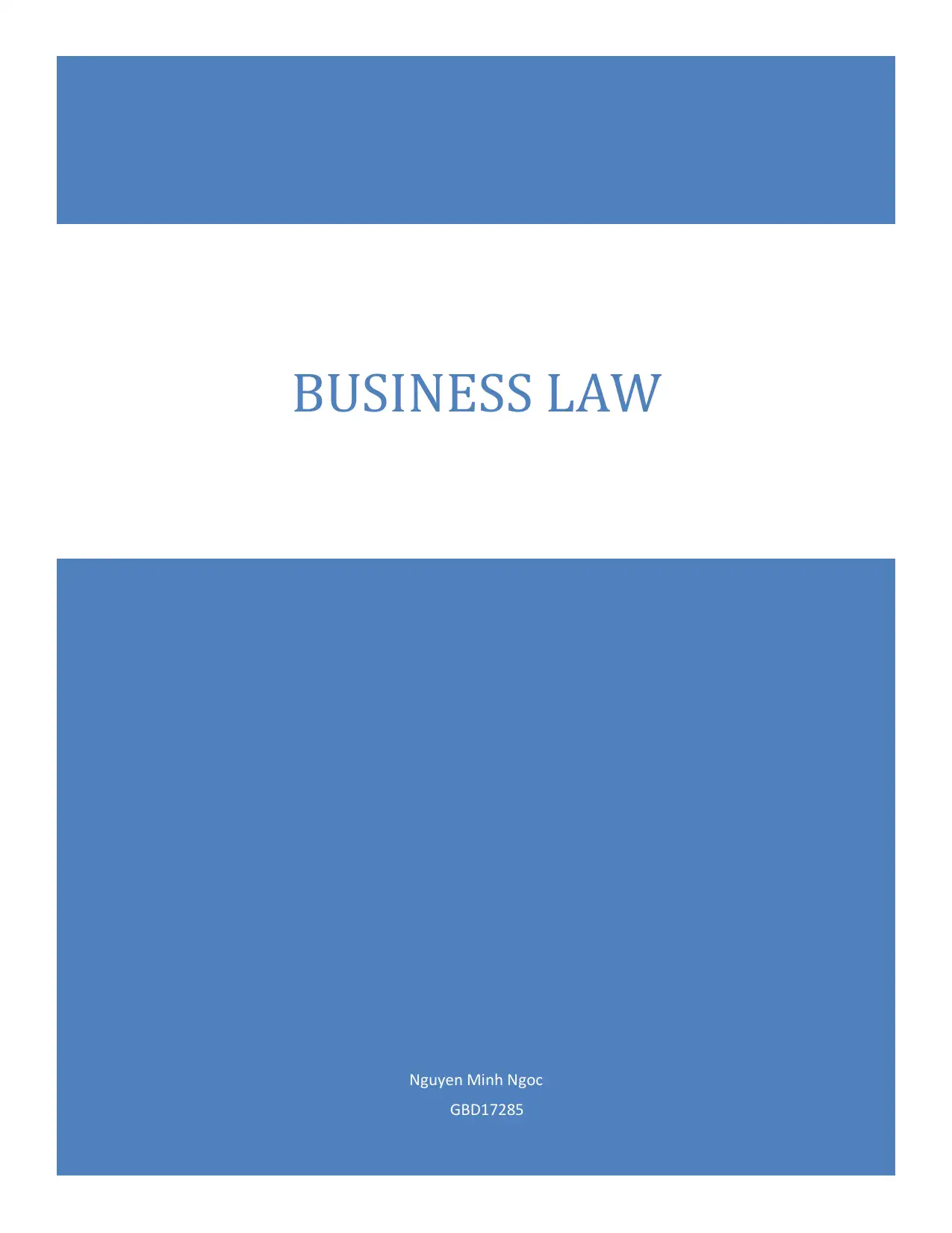
Nguyen Minh Ngoc
GBD17285
BUSINESS LAW
GBD17285
BUSINESS LAW
Secure Best Marks with AI Grader
Need help grading? Try our AI Grader for instant feedback on your assignments.
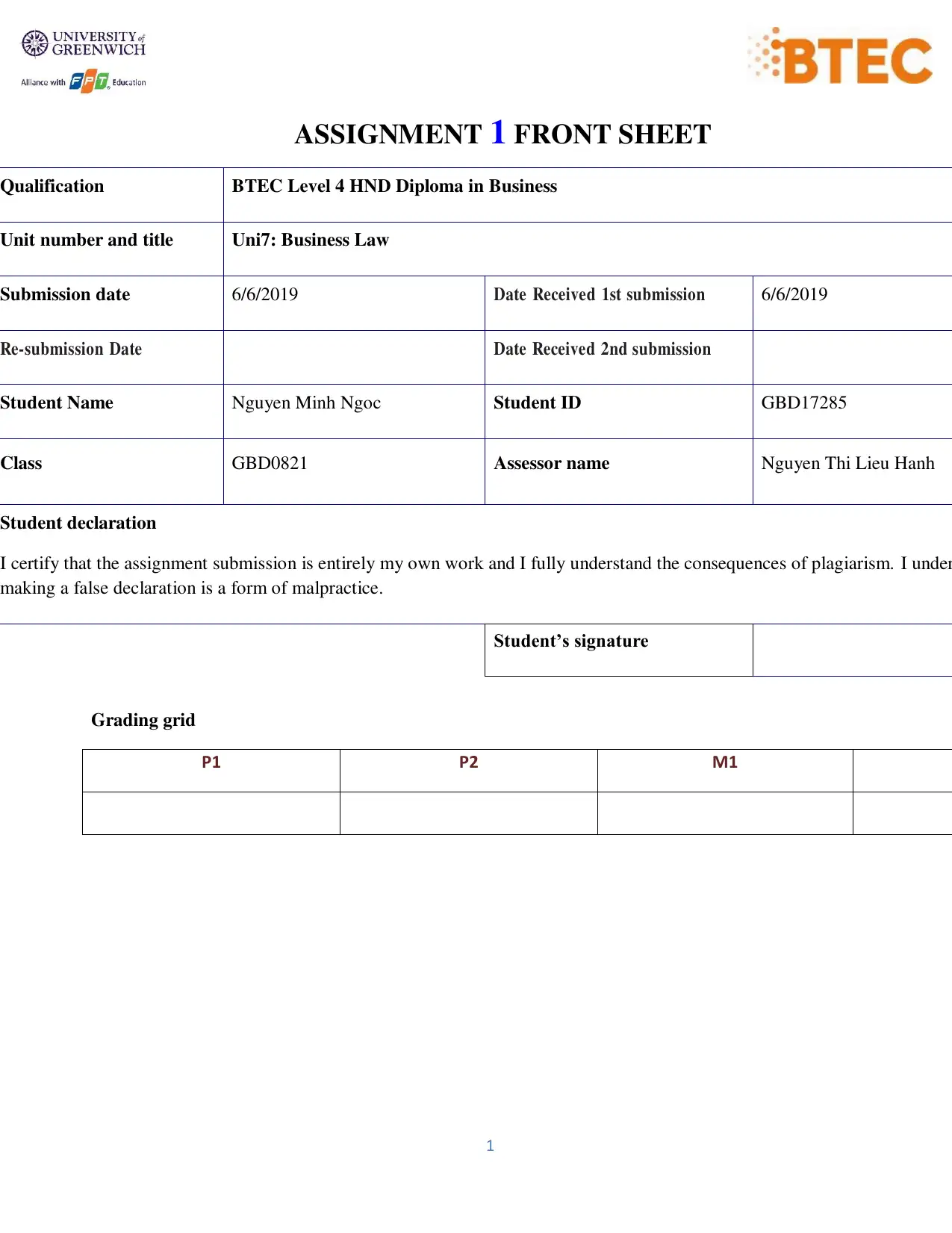
1
ASSIGNMENT 1 FRONT SHEET
Grading grid
P1 P2 M1
Qualification BTEC Level 4 HND Diploma in Business
Unit number and title Uni7: Business Law
Submission date 6/6/2019 Date Received 1st submission 6/6/2019
Re-submission Date Date Received 2nd submission
Student Name Nguyen Minh Ngoc Student ID GBD17285
Class GBD0821 Assessor name Nguyen Thi Lieu Hanh
Student declaration
I certify that the assignment submission is entirely my own work and I fully understand the consequences of plagiarism. I under
making a false declaration is a form of malpractice.
Student’s signature
ASSIGNMENT 1 FRONT SHEET
Grading grid
P1 P2 M1
Qualification BTEC Level 4 HND Diploma in Business
Unit number and title Uni7: Business Law
Submission date 6/6/2019 Date Received 1st submission 6/6/2019
Re-submission Date Date Received 2nd submission
Student Name Nguyen Minh Ngoc Student ID GBD17285
Class GBD0821 Assessor name Nguyen Thi Lieu Hanh
Student declaration
I certify that the assignment submission is entirely my own work and I fully understand the consequences of plagiarism. I under
making a false declaration is a form of malpractice.
Student’s signature
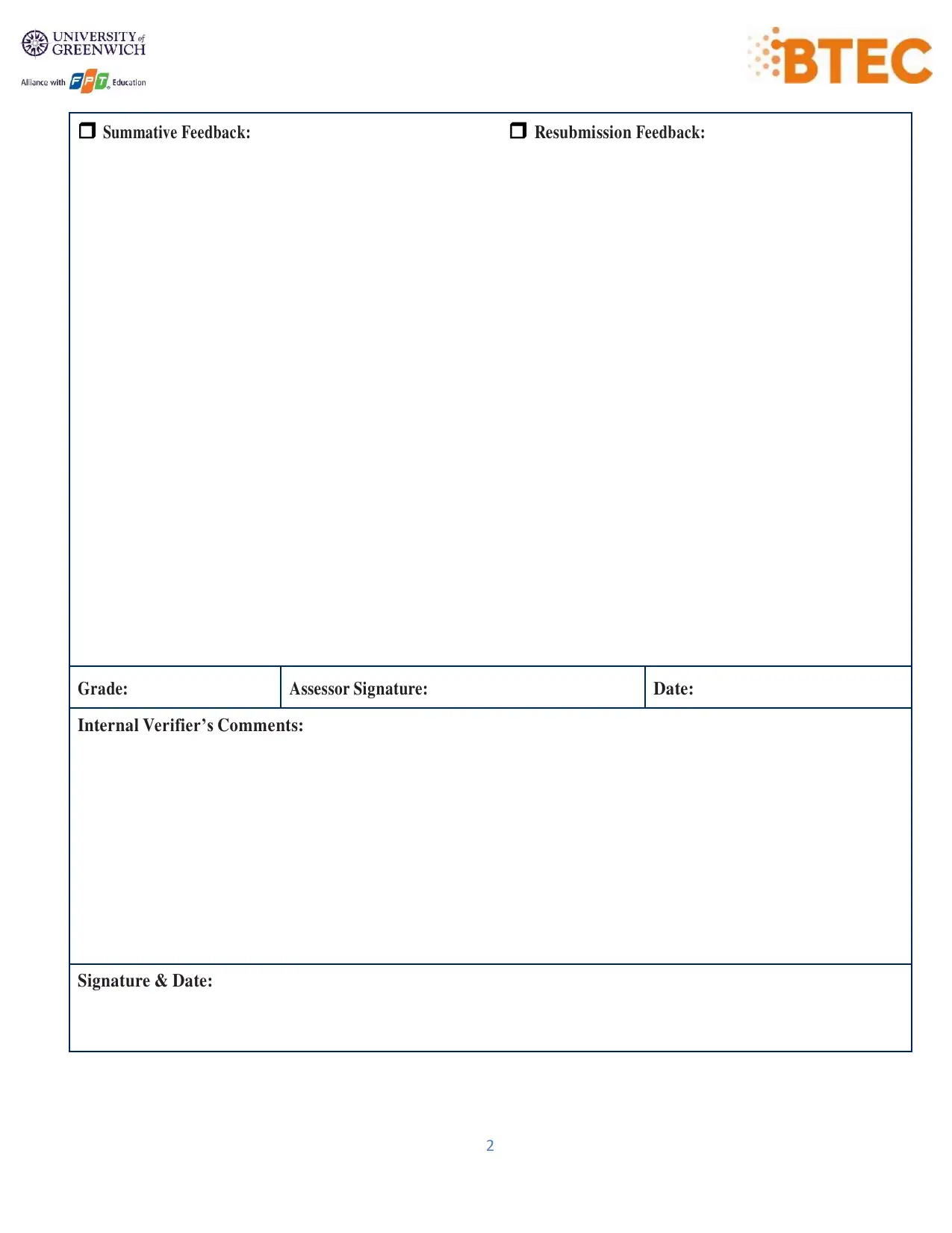
2
Summative Feedback: Resubmission Feedback:
Grade: Assessor Signature: Date:
Internal Verifier’s Comments:
Signature & Date:
Summative Feedback: Resubmission Feedback:
Grade: Assessor Signature: Date:
Internal Verifier’s Comments:
Signature & Date:
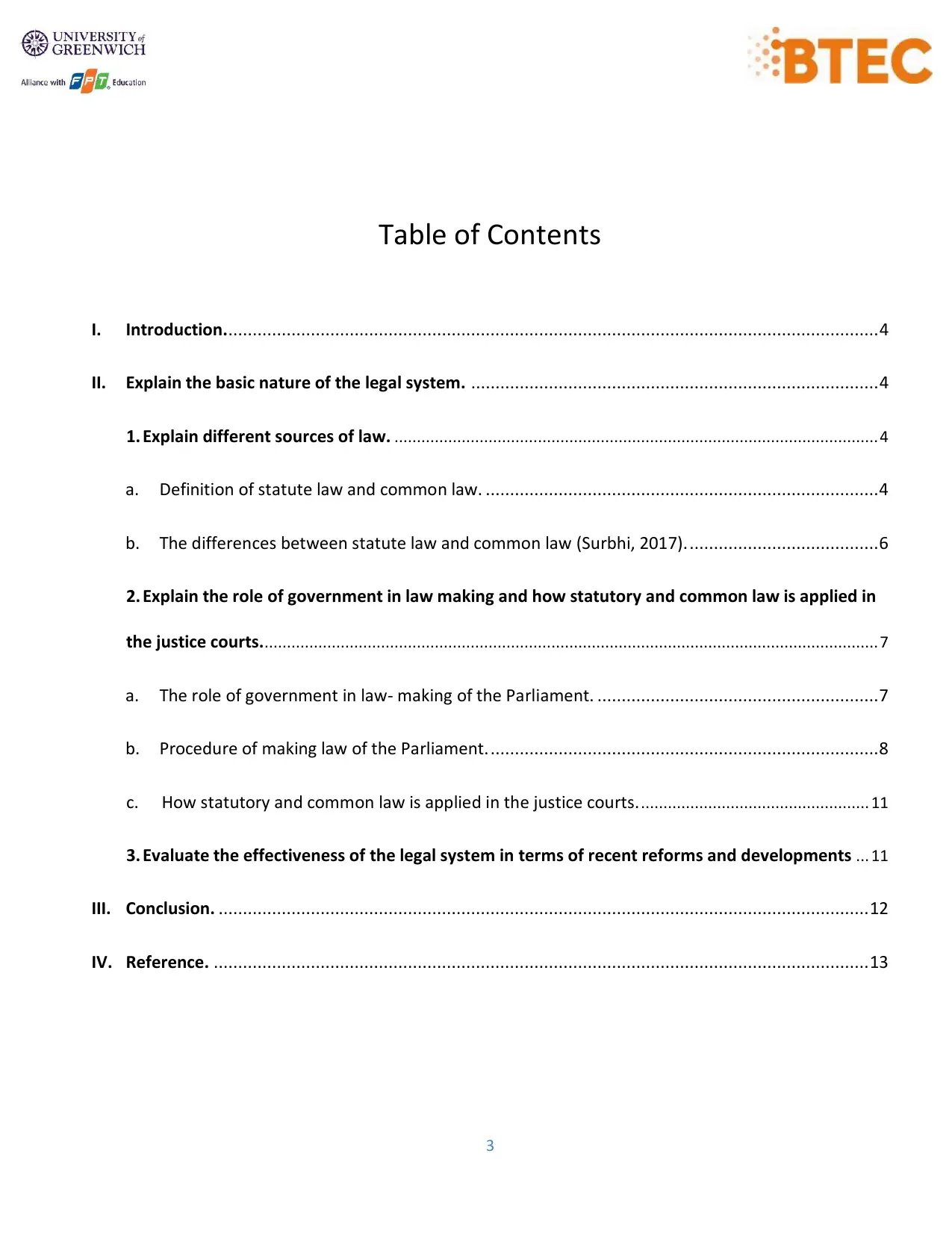
3
Table of Contents
I. Introduction....................................................................................................................................... 4
II. Explain the basic nature of the legal system. .................................................................................... 4
1. Explain different sources of law. ............................................................................................................ 4
a. Definition of statute law and common law. .................................................................................4
b. The differences between statute law and common law (Surbhi, 2017). .......................................6
2. Explain the role of government in law making and how statutory and common law is applied in
the justice courts.......................................................................................................................................... 7
a. The role of government in law- making of the Parliament. .......................................................... 7
b. Procedure of making law of the Parliament. ................................................................................8
c. How statutory and common law is applied in the justice courts. ................................................... 11
3. Evaluate the effectiveness of the legal system in terms of recent reforms and developments ... 11
III. Conclusion. ...................................................................................................................................... 12
IV. Reference. ....................................................................................................................................... 13
Table of Contents
I. Introduction....................................................................................................................................... 4
II. Explain the basic nature of the legal system. .................................................................................... 4
1. Explain different sources of law. ............................................................................................................ 4
a. Definition of statute law and common law. .................................................................................4
b. The differences between statute law and common law (Surbhi, 2017). .......................................6
2. Explain the role of government in law making and how statutory and common law is applied in
the justice courts.......................................................................................................................................... 7
a. The role of government in law- making of the Parliament. .......................................................... 7
b. Procedure of making law of the Parliament. ................................................................................8
c. How statutory and common law is applied in the justice courts. ................................................... 11
3. Evaluate the effectiveness of the legal system in terms of recent reforms and developments ... 11
III. Conclusion. ...................................................................................................................................... 12
IV. Reference. ....................................................................................................................................... 13
Secure Best Marks with AI Grader
Need help grading? Try our AI Grader for instant feedback on your assignments.
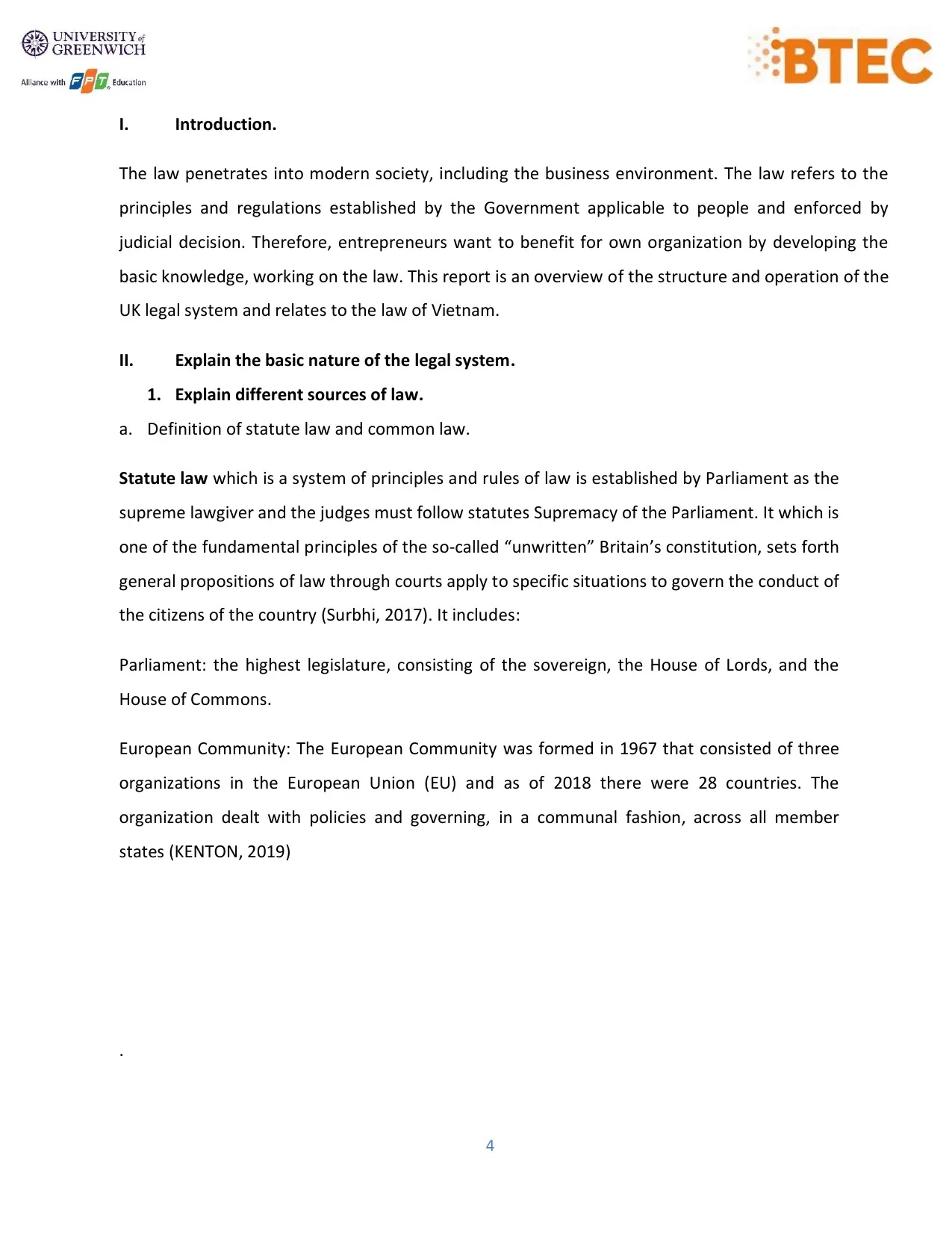
4
I. Introduction.
The law penetrates into modern society, including the business environment. The law refers to the
principles and regulations established by the Government applicable to people and enforced by
judicial decision. Therefore, entrepreneurs want to benefit for own organization by developing the
basic knowledge, working on the law. This report is an overview of the structure and operation of the
UK legal system and relates to the law of Vietnam.
II. Explain the basic nature of the legal system.
1. Explain different sources of law.
a. Definition of statute law and common law.
Statute law which is a system of principles and rules of law is established by Parliament as the
supreme lawgiver and the judges must follow statutes Supremacy of the Parliament. It which is
one of the fundamental principles of the so-called “unwritten” Britain’s constitution, sets forth
general propositions of law through courts apply to specific situations to govern the conduct of
the citizens of the country (Surbhi, 2017). It includes:
Parliament: the highest legislature, consisting of the sovereign, the House of Lords, and the
House of Commons.
European Community: The European Community was formed in 1967 that consisted of three
organizations in the European Union (EU) and as of 2018 there were 28 countries. The
organization dealt with policies and governing, in a communal fashion, across all member
states (KENTON, 2019)
.
I. Introduction.
The law penetrates into modern society, including the business environment. The law refers to the
principles and regulations established by the Government applicable to people and enforced by
judicial decision. Therefore, entrepreneurs want to benefit for own organization by developing the
basic knowledge, working on the law. This report is an overview of the structure and operation of the
UK legal system and relates to the law of Vietnam.
II. Explain the basic nature of the legal system.
1. Explain different sources of law.
a. Definition of statute law and common law.
Statute law which is a system of principles and rules of law is established by Parliament as the
supreme lawgiver and the judges must follow statutes Supremacy of the Parliament. It which is
one of the fundamental principles of the so-called “unwritten” Britain’s constitution, sets forth
general propositions of law through courts apply to specific situations to govern the conduct of
the citizens of the country (Surbhi, 2017). It includes:
Parliament: the highest legislature, consisting of the sovereign, the House of Lords, and the
House of Commons.
European Community: The European Community was formed in 1967 that consisted of three
organizations in the European Union (EU) and as of 2018 there were 28 countries. The
organization dealt with policies and governing, in a communal fashion, across all member
states (KENTON, 2019)
.
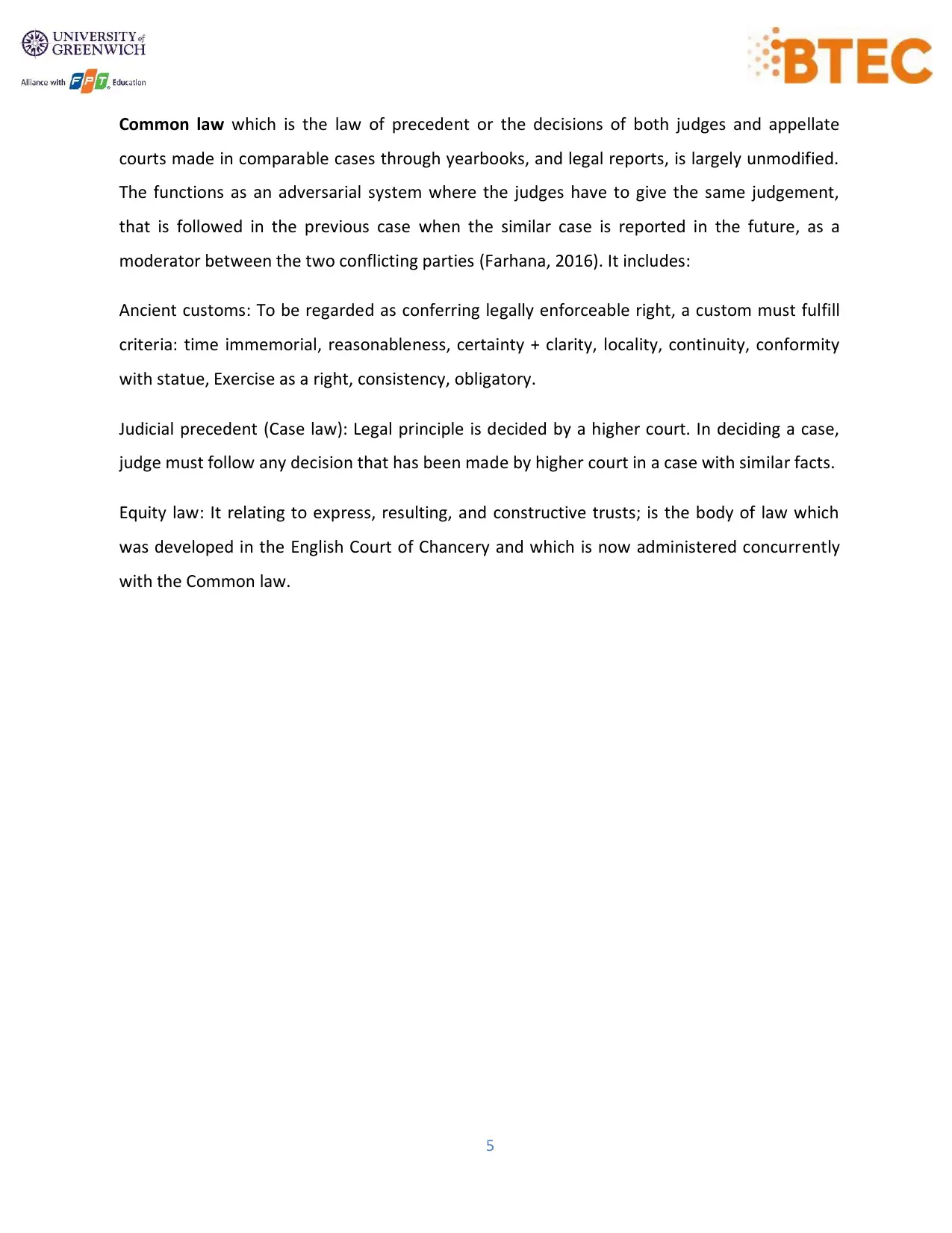
5
Common law which is the law of precedent or the decisions of both judges and appellate
courts made in comparable cases through yearbooks, and legal reports, is largely unmodified.
The functions as an adversarial system where the judges have to give the same judgement,
that is followed in the previous case when the similar case is reported in the future, as a
moderator between the two conflicting parties (Farhana, 2016). It includes:
Ancient customs: To be regarded as conferring legally enforceable right, a custom must fulfill
criteria: time immemorial, reasonableness, certainty + clarity, locality, continuity, conformity
with statue, Exercise as a right, consistency, obligatory.
Judicial precedent (Case law): Legal principle is decided by a higher court. In deciding a case,
judge must follow any decision that has been made by higher court in a case with similar facts.
Equity law: It relating to express, resulting, and constructive trusts; is the body of law which
was developed in the English Court of Chancery and which is now administered concurrently
with the Common law.
Common law which is the law of precedent or the decisions of both judges and appellate
courts made in comparable cases through yearbooks, and legal reports, is largely unmodified.
The functions as an adversarial system where the judges have to give the same judgement,
that is followed in the previous case when the similar case is reported in the future, as a
moderator between the two conflicting parties (Farhana, 2016). It includes:
Ancient customs: To be regarded as conferring legally enforceable right, a custom must fulfill
criteria: time immemorial, reasonableness, certainty + clarity, locality, continuity, conformity
with statue, Exercise as a right, consistency, obligatory.
Judicial precedent (Case law): Legal principle is decided by a higher court. In deciding a case,
judge must follow any decision that has been made by higher court in a case with similar facts.
Equity law: It relating to express, resulting, and constructive trusts; is the body of law which
was developed in the English Court of Chancery and which is now administered concurrently
with the Common law.
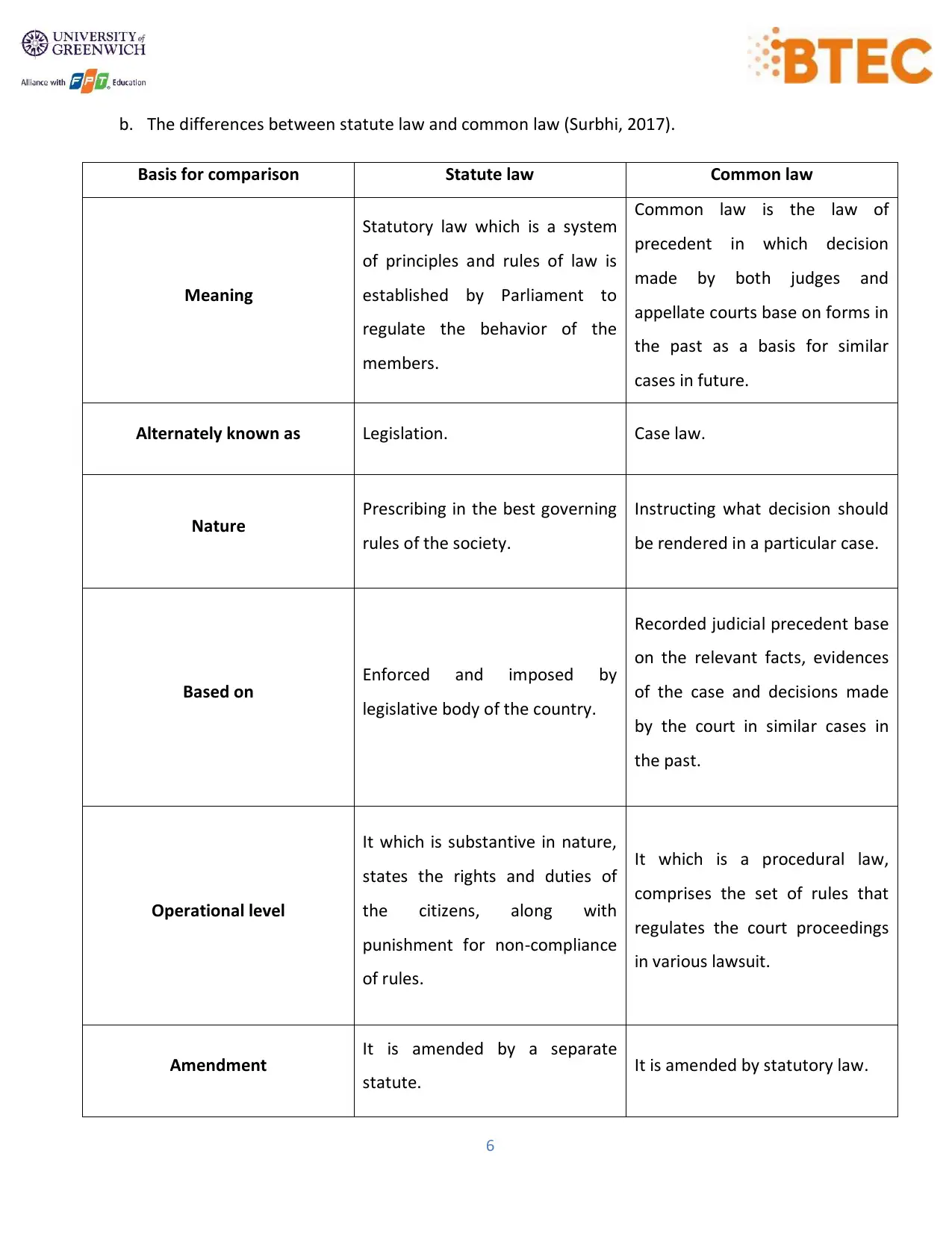
6
b. The differences between statute law and common law (Surbhi, 2017).
Basis for comparison Statute law Common law
Meaning
Statutory law which is a system
of principles and rules of law is
established by Parliament to
regulate the behavior of the
members.
Common law is the law of
precedent in which decision
made by both judges and
appellate courts base on forms in
the past as a basis for similar
cases in future.
Alternately known as Legislation. Case law.
Nature Prescribing in the best governing
rules of the society.
Instructing what decision should
be rendered in a particular case.
Based on Enforced and imposed by
legislative body of the country.
Recorded judicial precedent base
on the relevant facts, evidences
of the case and decisions made
by the court in similar cases in
the past.
Operational level
It which is substantive in nature,
states the rights and duties of
the citizens, along with
punishment for non-compliance
of rules.
It which is a procedural law,
comprises the set of rules that
regulates the court proceedings
in various lawsuit.
Amendment It is amended by a separate
statute. It is amended by statutory law.
b. The differences between statute law and common law (Surbhi, 2017).
Basis for comparison Statute law Common law
Meaning
Statutory law which is a system
of principles and rules of law is
established by Parliament to
regulate the behavior of the
members.
Common law is the law of
precedent in which decision
made by both judges and
appellate courts base on forms in
the past as a basis for similar
cases in future.
Alternately known as Legislation. Case law.
Nature Prescribing in the best governing
rules of the society.
Instructing what decision should
be rendered in a particular case.
Based on Enforced and imposed by
legislative body of the country.
Recorded judicial precedent base
on the relevant facts, evidences
of the case and decisions made
by the court in similar cases in
the past.
Operational level
It which is substantive in nature,
states the rights and duties of
the citizens, along with
punishment for non-compliance
of rules.
It which is a procedural law,
comprises the set of rules that
regulates the court proceedings
in various lawsuit.
Amendment It is amended by a separate
statute. It is amended by statutory law.
Paraphrase This Document
Need a fresh take? Get an instant paraphrase of this document with our AI Paraphraser
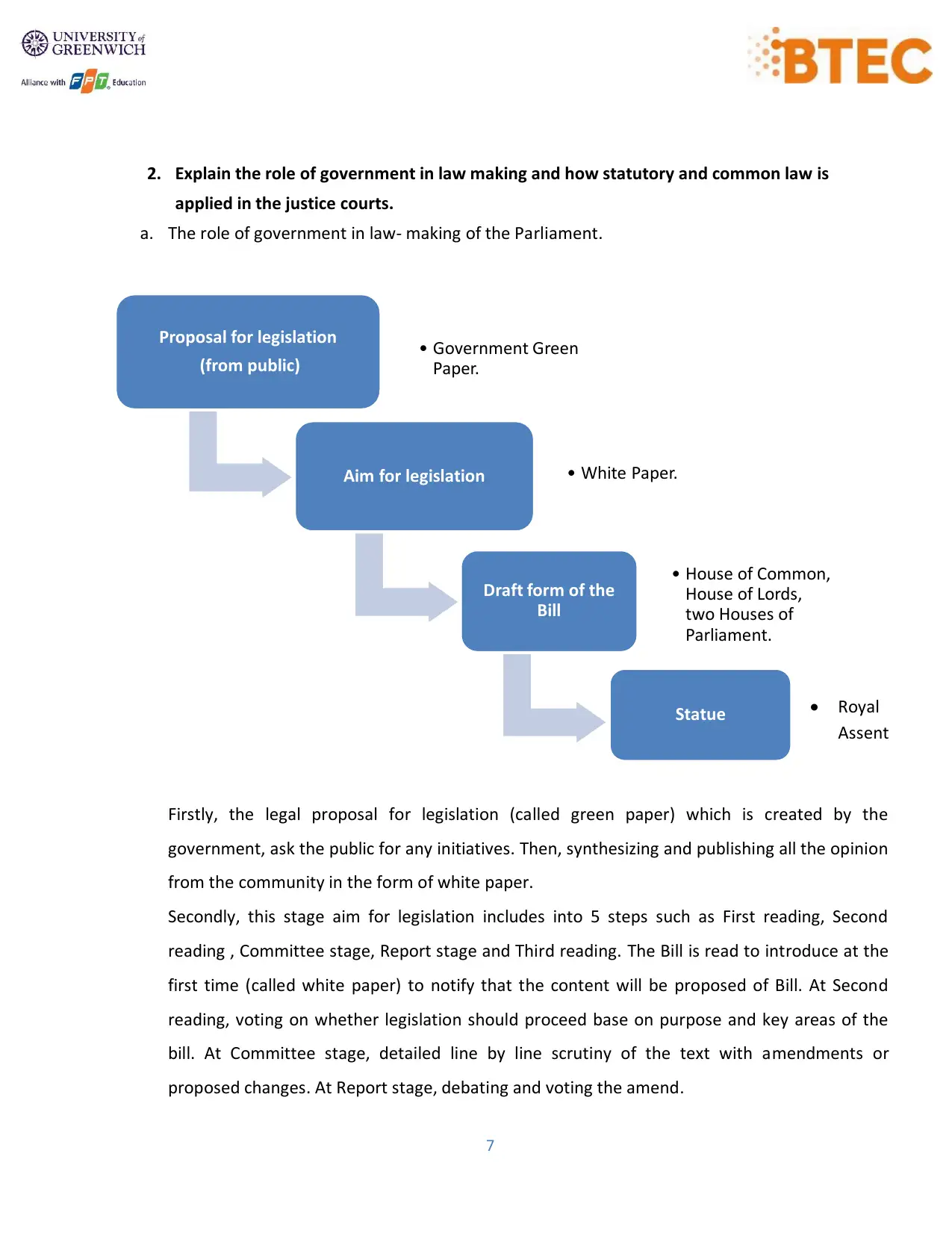
7
2. Explain the role of government in law making and how statutory and common law is
applied in the justice courts.
a. The role of government in law- making of the Parliament.
Firstly, the legal proposal for legislation (called green paper) which is created by the
government, ask the public for any initiatives. Then, synthesizing and publishing all the opinion
from the community in the form of white paper.
Secondly, this stage aim for legislation includes into 5 steps such as First reading, Second
reading , Committee stage, Report stage and Third reading. The Bill is read to introduce at the
first time (called white paper) to notify that the content will be proposed of Bill. At Second
reading, voting on whether legislation should proceed base on purpose and key areas of the
bill. At Committee stage, detailed line by line scrutiny of the text with amendments or
proposed changes. At Report stage, debating and voting the amend.
Proposal for legislation
(from public) • Government Green
Paper.
Aim for legislation • White Paper.
Draft form of the
Bill
• House of Common,
House of Lords,
two Houses of
Parliament.
Statue • Royal
Assent
2. Explain the role of government in law making and how statutory and common law is
applied in the justice courts.
a. The role of government in law- making of the Parliament.
Firstly, the legal proposal for legislation (called green paper) which is created by the
government, ask the public for any initiatives. Then, synthesizing and publishing all the opinion
from the community in the form of white paper.
Secondly, this stage aim for legislation includes into 5 steps such as First reading, Second
reading , Committee stage, Report stage and Third reading. The Bill is read to introduce at the
first time (called white paper) to notify that the content will be proposed of Bill. At Second
reading, voting on whether legislation should proceed base on purpose and key areas of the
bill. At Committee stage, detailed line by line scrutiny of the text with amendments or
proposed changes. At Report stage, debating and voting the amend.
Proposal for legislation
(from public) • Government Green
Paper.
Aim for legislation • White Paper.
Draft form of the
Bill
• House of Common,
House of Lords,
two Houses of
Parliament.
Statue • Royal
Assent
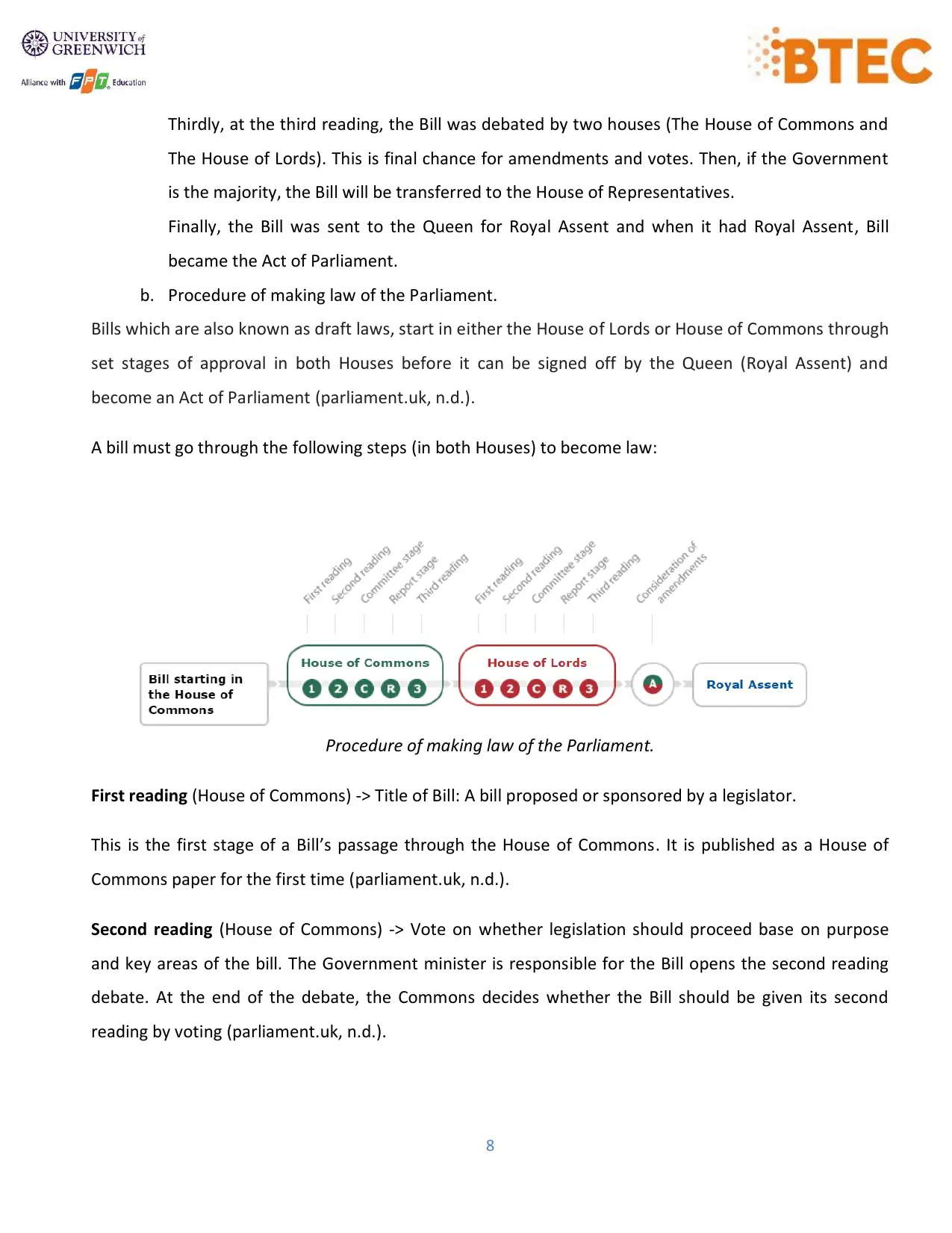
8
Thirdly, at the third reading, the Bill was debated by two houses (The House of Commons and
The House of Lords). This is final chance for amendments and votes. Then, if the Government
is the majority, the Bill will be transferred to the House of Representatives.
Finally, the Bill was sent to the Queen for Royal Assent and when it had Royal Assent, Bill
became the Act of Parliament.
b. Procedure of making law of the Parliament.
Bills which are also known as draft laws, start in either the House of Lords or House of Commons through
set stages of approval in both Houses before it can be signed off by the Queen (Royal Assent) and
become an Act of Parliament (parliament.uk, n.d.).
A bill must go through the following steps (in both Houses) to become law:
Procedure of making law of the Parliament.
First reading (House of Commons) -> Title of Bill: A bill proposed or sponsored by a legislator.
This is the first stage of a Bill’s passage through the House of Commons. It is published as a House of
Commons paper for the first time (parliament.uk, n.d.).
Second reading (House of Commons) -> Vote on whether legislation should proceed base on purpose
and key areas of the bill. The Government minister is responsible for the Bill opens the second reading
debate. At the end of the debate, the Commons decides whether the Bill should be given its second
reading by voting (parliament.uk, n.d.).
Thirdly, at the third reading, the Bill was debated by two houses (The House of Commons and
The House of Lords). This is final chance for amendments and votes. Then, if the Government
is the majority, the Bill will be transferred to the House of Representatives.
Finally, the Bill was sent to the Queen for Royal Assent and when it had Royal Assent, Bill
became the Act of Parliament.
b. Procedure of making law of the Parliament.
Bills which are also known as draft laws, start in either the House of Lords or House of Commons through
set stages of approval in both Houses before it can be signed off by the Queen (Royal Assent) and
become an Act of Parliament (parliament.uk, n.d.).
A bill must go through the following steps (in both Houses) to become law:
Procedure of making law of the Parliament.
First reading (House of Commons) -> Title of Bill: A bill proposed or sponsored by a legislator.
This is the first stage of a Bill’s passage through the House of Commons. It is published as a House of
Commons paper for the first time (parliament.uk, n.d.).
Second reading (House of Commons) -> Vote on whether legislation should proceed base on purpose
and key areas of the bill. The Government minister is responsible for the Bill opens the second reading
debate. At the end of the debate, the Commons decides whether the Bill should be given its second
reading by voting (parliament.uk, n.d.).
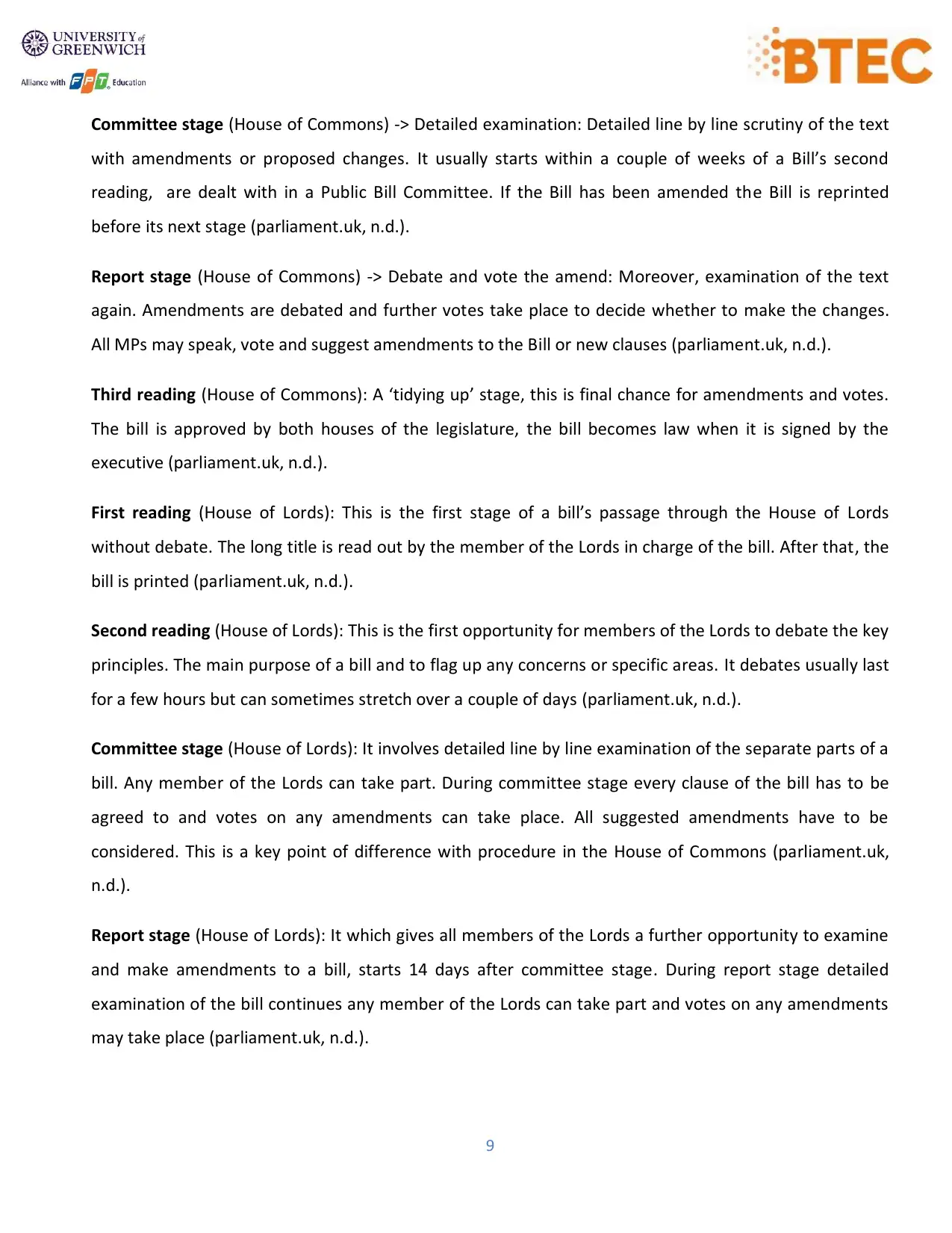
9
Committee stage (House of Commons) -> Detailed examination: Detailed line by line scrutiny of the text
with amendments or proposed changes. It usually starts within a couple of weeks of a Bill’s second
reading, are dealt with in a Public Bill Committee. If the Bill has been amended the Bill is reprinted
before its next stage (parliament.uk, n.d.).
Report stage (House of Commons) -> Debate and vote the amend: Moreover, examination of the text
again. Amendments are debated and further votes take place to decide whether to make the changes.
All MPs may speak, vote and suggest amendments to the Bill or new clauses (parliament.uk, n.d.).
Third reading (House of Commons): A ‘tidying up’ stage, this is final chance for amendments and votes.
The bill is approved by both houses of the legislature, the bill becomes law when it is signed by the
executive (parliament.uk, n.d.).
First reading (House of Lords): This is the first stage of a bill’s passage through the House of Lords
without debate. The long title is read out by the member of the Lords in charge of the bill. After that, the
bill is printed (parliament.uk, n.d.).
Second reading (House of Lords): This is the first opportunity for members of the Lords to debate the key
principles. The main purpose of a bill and to flag up any concerns or specific areas. It debates usually last
for a few hours but can sometimes stretch over a couple of days (parliament.uk, n.d.).
Committee stage (House of Lords): It involves detailed line by line examination of the separate parts of a
bill. Any member of the Lords can take part. During committee stage every clause of the bill has to be
agreed to and votes on any amendments can take place. All suggested amendments have to be
considered. This is a key point of difference with procedure in the House of Commons (parliament.uk,
n.d.).
Report stage (House of Lords): It which gives all members of the Lords a further opportunity to examine
and make amendments to a bill, starts 14 days after committee stage. During report stage detailed
examination of the bill continues any member of the Lords can take part and votes on any amendments
may take place (parliament.uk, n.d.).
Committee stage (House of Commons) -> Detailed examination: Detailed line by line scrutiny of the text
with amendments or proposed changes. It usually starts within a couple of weeks of a Bill’s second
reading, are dealt with in a Public Bill Committee. If the Bill has been amended the Bill is reprinted
before its next stage (parliament.uk, n.d.).
Report stage (House of Commons) -> Debate and vote the amend: Moreover, examination of the text
again. Amendments are debated and further votes take place to decide whether to make the changes.
All MPs may speak, vote and suggest amendments to the Bill or new clauses (parliament.uk, n.d.).
Third reading (House of Commons): A ‘tidying up’ stage, this is final chance for amendments and votes.
The bill is approved by both houses of the legislature, the bill becomes law when it is signed by the
executive (parliament.uk, n.d.).
First reading (House of Lords): This is the first stage of a bill’s passage through the House of Lords
without debate. The long title is read out by the member of the Lords in charge of the bill. After that, the
bill is printed (parliament.uk, n.d.).
Second reading (House of Lords): This is the first opportunity for members of the Lords to debate the key
principles. The main purpose of a bill and to flag up any concerns or specific areas. It debates usually last
for a few hours but can sometimes stretch over a couple of days (parliament.uk, n.d.).
Committee stage (House of Lords): It involves detailed line by line examination of the separate parts of a
bill. Any member of the Lords can take part. During committee stage every clause of the bill has to be
agreed to and votes on any amendments can take place. All suggested amendments have to be
considered. This is a key point of difference with procedure in the House of Commons (parliament.uk,
n.d.).
Report stage (House of Lords): It which gives all members of the Lords a further opportunity to examine
and make amendments to a bill, starts 14 days after committee stage. During report stage detailed
examination of the bill continues any member of the Lords can take part and votes on any amendments
may take place (parliament.uk, n.d.).
Secure Best Marks with AI Grader
Need help grading? Try our AI Grader for instant feedback on your assignments.
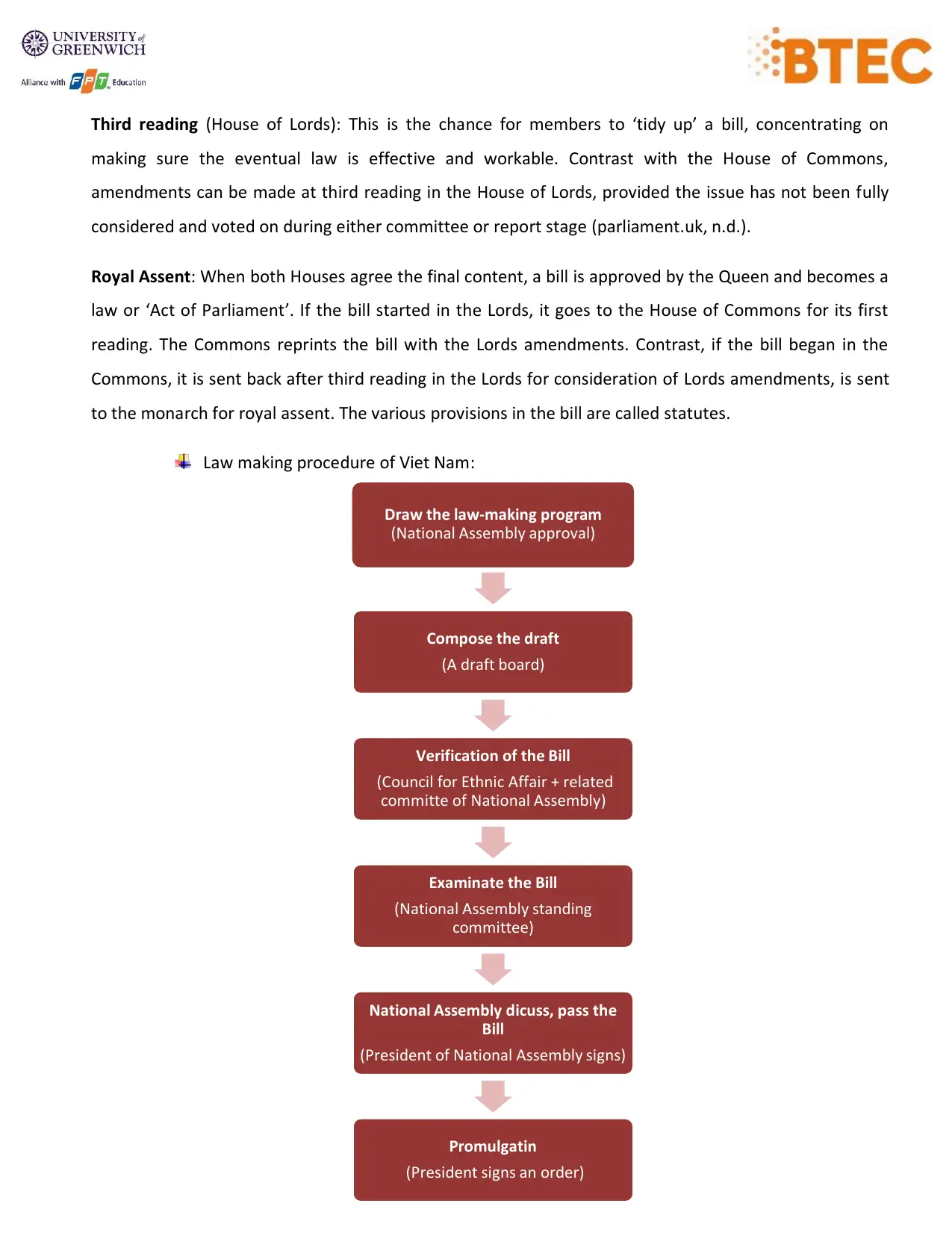
10
Third reading (House of Lords): This is the chance for members to ‘tidy up’ a bill, concentrating on
making sure the eventual law is effective and workable. Contrast with the House of Commons,
amendments can be made at third reading in the House of Lords, provided the issue has not been fully
considered and voted on during either committee or report stage (parliament.uk, n.d.).
Royal Assent: When both Houses agree the final content, a bill is approved by the Queen and becomes a
law or ‘Act of Parliament’. If the bill started in the Lords, it goes to the House of Commons for its first
reading. The Commons reprints the bill with the Lords amendments. Contrast, if the bill began in the
Commons, it is sent back after third reading in the Lords for consideration of Lords amendments, is sent
to the monarch for royal assent. The various provisions in the bill are called statutes.
Law making procedure of Viet Nam:
Draw the law-making program
(National Assembly approval)
Compose the draft
(A draft board)
Verification of the Bill
(Council for Ethnic Affair + related
committe of National Assembly)
Examinate the Bill
(National Assembly standing
committee)
National Assembly dicuss, pass the
Bill
(President of National Assembly signs)
Promulgatin
(President signs an order)
Third reading (House of Lords): This is the chance for members to ‘tidy up’ a bill, concentrating on
making sure the eventual law is effective and workable. Contrast with the House of Commons,
amendments can be made at third reading in the House of Lords, provided the issue has not been fully
considered and voted on during either committee or report stage (parliament.uk, n.d.).
Royal Assent: When both Houses agree the final content, a bill is approved by the Queen and becomes a
law or ‘Act of Parliament’. If the bill started in the Lords, it goes to the House of Commons for its first
reading. The Commons reprints the bill with the Lords amendments. Contrast, if the bill began in the
Commons, it is sent back after third reading in the Lords for consideration of Lords amendments, is sent
to the monarch for royal assent. The various provisions in the bill are called statutes.
Law making procedure of Viet Nam:
Draw the law-making program
(National Assembly approval)
Compose the draft
(A draft board)
Verification of the Bill
(Council for Ethnic Affair + related
committe of National Assembly)
Examinate the Bill
(National Assembly standing
committee)
National Assembly dicuss, pass the
Bill
(President of National Assembly signs)
Promulgatin
(President signs an order)
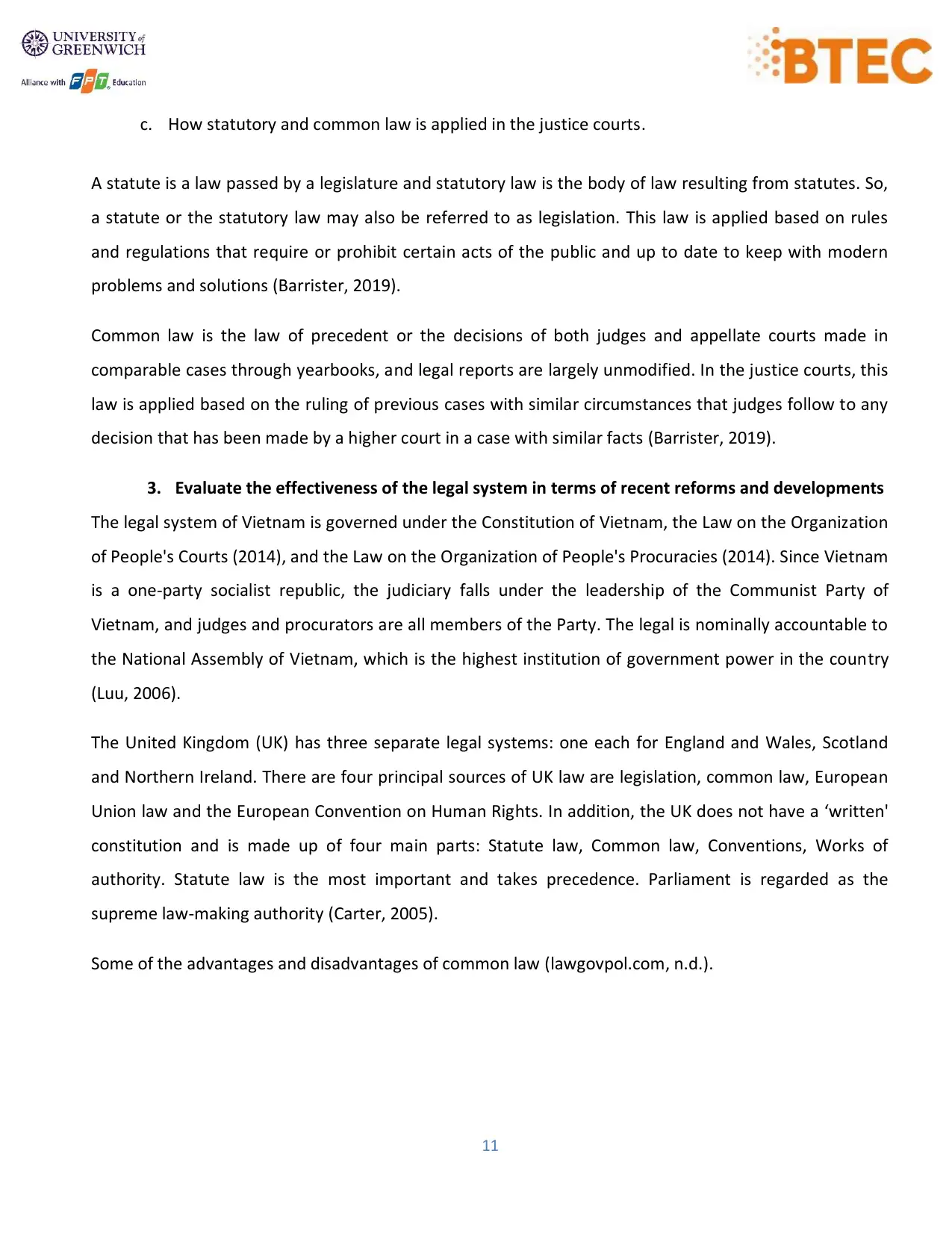
11
c. How statutory and common law is applied in the justice courts.
A statute is a law passed by a legislature and statutory law is the body of law resulting from statutes. So,
a statute or the statutory law may also be referred to as legislation. This law is applied based on rules
and regulations that require or prohibit certain acts of the public and up to date to keep with modern
problems and solutions (Barrister, 2019).
Common law is the law of precedent or the decisions of both judges and appellate courts made in
comparable cases through yearbooks, and legal reports are largely unmodified. In the justice courts, this
law is applied based on the ruling of previous cases with similar circumstances that judges follow to any
decision that has been made by a higher court in a case with similar facts (Barrister, 2019).
3. Evaluate the effectiveness of the legal system in terms of recent reforms and developments
The legal system of Vietnam is governed under the Constitution of Vietnam, the Law on the Organization
of People's Courts (2014), and the Law on the Organization of People's Procuracies (2014). Since Vietnam
is a one-party socialist republic, the judiciary falls under the leadership of the Communist Party of
Vietnam, and judges and procurators are all members of the Party. The legal is nominally accountable to
the National Assembly of Vietnam, which is the highest institution of government power in the country
(Luu, 2006).
The United Kingdom (UK) has three separate legal systems: one each for England and Wales, Scotland
and Northern Ireland. There are four principal sources of UK law are legislation, common law, European
Union law and the European Convention on Human Rights. In addition, the UK does not have a ‘written'
constitution and is made up of four main parts: Statute law, Common law, Conventions, Works of
authority. Statute law is the most important and takes precedence. Parliament is regarded as the
supreme law-making authority (Carter, 2005).
Some of the advantages and disadvantages of common law (lawgovpol.com, n.d.).
c. How statutory and common law is applied in the justice courts.
A statute is a law passed by a legislature and statutory law is the body of law resulting from statutes. So,
a statute or the statutory law may also be referred to as legislation. This law is applied based on rules
and regulations that require or prohibit certain acts of the public and up to date to keep with modern
problems and solutions (Barrister, 2019).
Common law is the law of precedent or the decisions of both judges and appellate courts made in
comparable cases through yearbooks, and legal reports are largely unmodified. In the justice courts, this
law is applied based on the ruling of previous cases with similar circumstances that judges follow to any
decision that has been made by a higher court in a case with similar facts (Barrister, 2019).
3. Evaluate the effectiveness of the legal system in terms of recent reforms and developments
The legal system of Vietnam is governed under the Constitution of Vietnam, the Law on the Organization
of People's Courts (2014), and the Law on the Organization of People's Procuracies (2014). Since Vietnam
is a one-party socialist republic, the judiciary falls under the leadership of the Communist Party of
Vietnam, and judges and procurators are all members of the Party. The legal is nominally accountable to
the National Assembly of Vietnam, which is the highest institution of government power in the country
(Luu, 2006).
The United Kingdom (UK) has three separate legal systems: one each for England and Wales, Scotland
and Northern Ireland. There are four principal sources of UK law are legislation, common law, European
Union law and the European Convention on Human Rights. In addition, the UK does not have a ‘written'
constitution and is made up of four main parts: Statute law, Common law, Conventions, Works of
authority. Statute law is the most important and takes precedence. Parliament is regarded as the
supreme law-making authority (Carter, 2005).
Some of the advantages and disadvantages of common law (lawgovpol.com, n.d.).
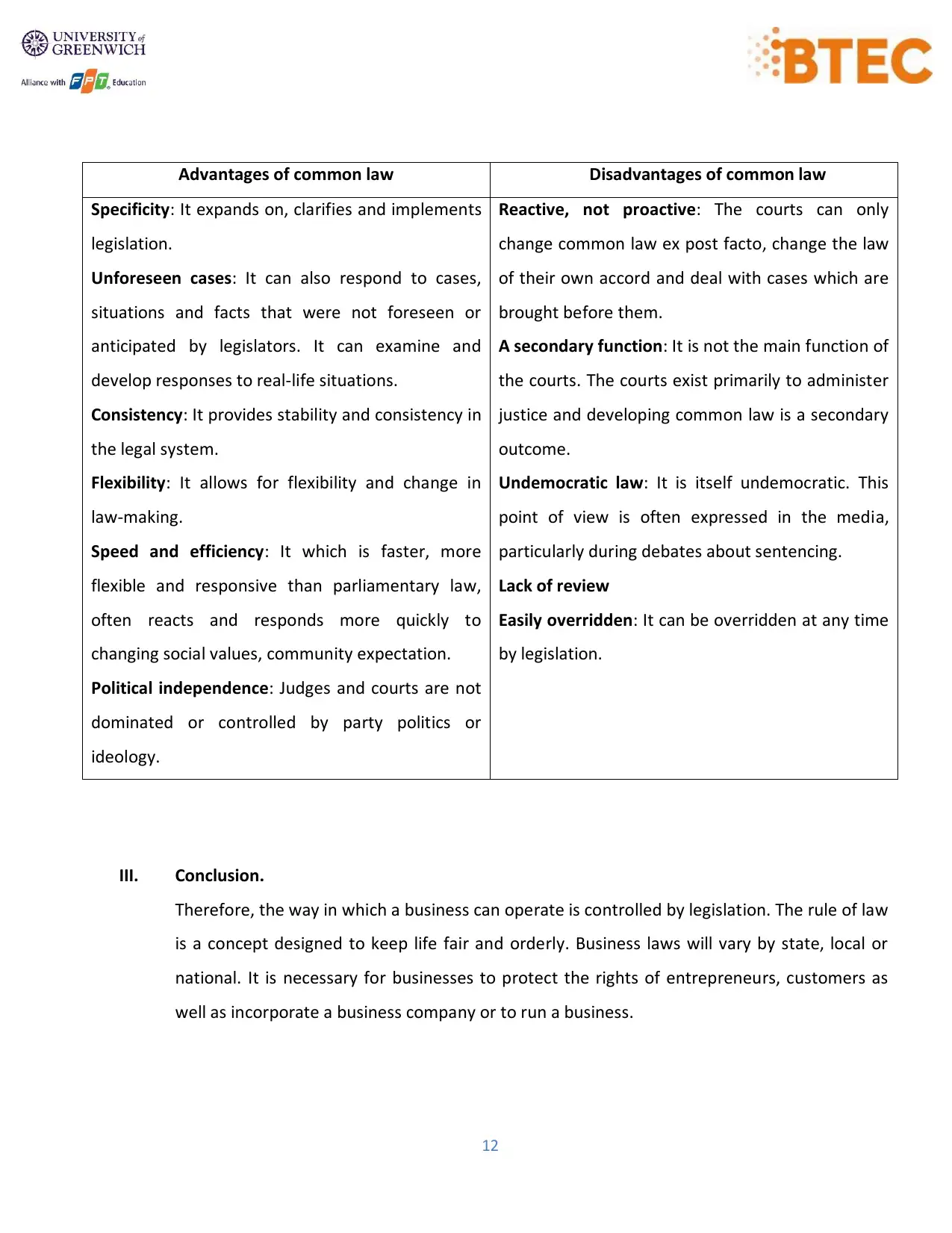
12
Advantages of common law Disadvantages of common law
Specificity: It expands on, clarifies and implements
legislation.
Unforeseen cases: It can also respond to cases,
situations and facts that were not foreseen or
anticipated by legislators. It can examine and
develop responses to real-life situations.
Consistency: It provides stability and consistency in
the legal system.
Flexibility: It allows for flexibility and change in
law-making.
Speed and efficiency: It which is faster, more
flexible and responsive than parliamentary law,
often reacts and responds more quickly to
changing social values, community expectation.
Political independence: Judges and courts are not
dominated or controlled by party politics or
ideology.
Reactive, not proactive: The courts can only
change common law ex post facto, change the law
of their own accord and deal with cases which are
brought before them.
A secondary function: It is not the main function of
the courts. The courts exist primarily to administer
justice and developing common law is a secondary
outcome.
Undemocratic law: It is itself undemocratic. This
point of view is often expressed in the media,
particularly during debates about sentencing.
Lack of review
Easily overridden: It can be overridden at any time
by legislation.
III. Conclusion.
Therefore, the way in which a business can operate is controlled by legislation. The rule of law
is a concept designed to keep life fair and orderly. Business laws will vary by state, local or
national. It is necessary for businesses to protect the rights of entrepreneurs, customers as
well as incorporate a business company or to run a business.
Advantages of common law Disadvantages of common law
Specificity: It expands on, clarifies and implements
legislation.
Unforeseen cases: It can also respond to cases,
situations and facts that were not foreseen or
anticipated by legislators. It can examine and
develop responses to real-life situations.
Consistency: It provides stability and consistency in
the legal system.
Flexibility: It allows for flexibility and change in
law-making.
Speed and efficiency: It which is faster, more
flexible and responsive than parliamentary law,
often reacts and responds more quickly to
changing social values, community expectation.
Political independence: Judges and courts are not
dominated or controlled by party politics or
ideology.
Reactive, not proactive: The courts can only
change common law ex post facto, change the law
of their own accord and deal with cases which are
brought before them.
A secondary function: It is not the main function of
the courts. The courts exist primarily to administer
justice and developing common law is a secondary
outcome.
Undemocratic law: It is itself undemocratic. This
point of view is often expressed in the media,
particularly during debates about sentencing.
Lack of review
Easily overridden: It can be overridden at any time
by legislation.
III. Conclusion.
Therefore, the way in which a business can operate is controlled by legislation. The rule of law
is a concept designed to keep life fair and orderly. Business laws will vary by state, local or
national. It is necessary for businesses to protect the rights of entrepreneurs, customers as
well as incorporate a business company or to run a business.
Paraphrase This Document
Need a fresh take? Get an instant paraphrase of this document with our AI Paraphraser
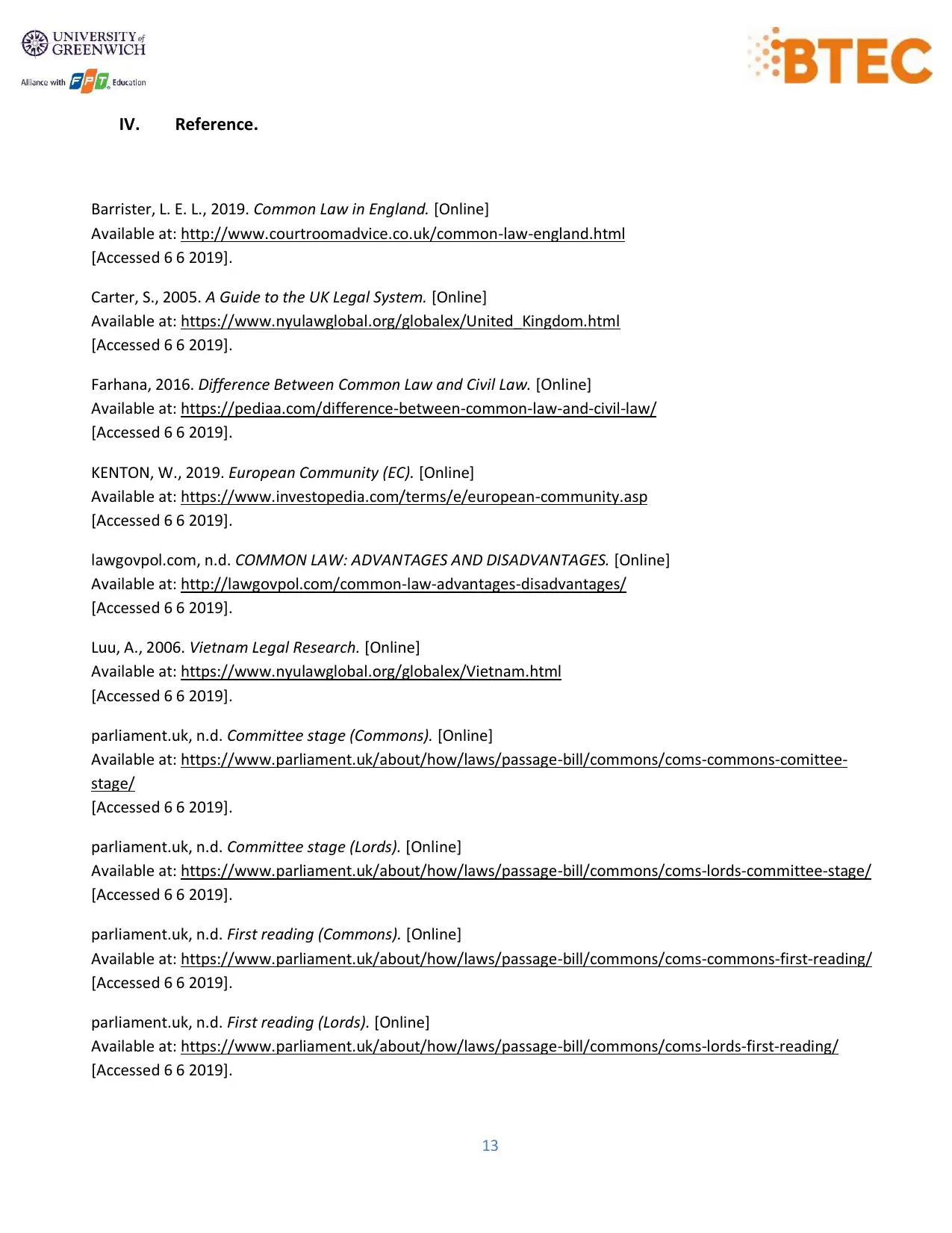
13
IV. Reference.
Barrister, L. E. L., 2019. Common Law in England. [Online]
Available at: http://www.courtroomadvice.co.uk/common-law-england.html
[Accessed 6 6 2019].
Carter, S., 2005. A Guide to the UK Legal System. [Online]
Available at: https://www.nyulawglobal.org/globalex/United_Kingdom.html
[Accessed 6 6 2019].
Farhana, 2016. Difference Between Common Law and Civil Law. [Online]
Available at: https://pediaa.com/difference-between-common-law-and-civil-law/
[Accessed 6 6 2019].
KENTON, W., 2019. European Community (EC). [Online]
Available at: https://www.investopedia.com/terms/e/european-community.asp
[Accessed 6 6 2019].
lawgovpol.com, n.d. COMMON LAW: ADVANTAGES AND DISADVANTAGES. [Online]
Available at: http://lawgovpol.com/common-law-advantages-disadvantages/
[Accessed 6 6 2019].
Luu, A., 2006. Vietnam Legal Research. [Online]
Available at: https://www.nyulawglobal.org/globalex/Vietnam.html
[Accessed 6 6 2019].
parliament.uk, n.d. Committee stage (Commons). [Online]
Available at: https://www.parliament.uk/about/how/laws/passage-bill/commons/coms-commons-comittee-
stage/
[Accessed 6 6 2019].
parliament.uk, n.d. Committee stage (Lords). [Online]
Available at: https://www.parliament.uk/about/how/laws/passage-bill/commons/coms-lords-committee-stage/
[Accessed 6 6 2019].
parliament.uk, n.d. First reading (Commons). [Online]
Available at: https://www.parliament.uk/about/how/laws/passage-bill/commons/coms-commons-first-reading/
[Accessed 6 6 2019].
parliament.uk, n.d. First reading (Lords). [Online]
Available at: https://www.parliament.uk/about/how/laws/passage-bill/commons/coms-lords-first-reading/
[Accessed 6 6 2019].
IV. Reference.
Barrister, L. E. L., 2019. Common Law in England. [Online]
Available at: http://www.courtroomadvice.co.uk/common-law-england.html
[Accessed 6 6 2019].
Carter, S., 2005. A Guide to the UK Legal System. [Online]
Available at: https://www.nyulawglobal.org/globalex/United_Kingdom.html
[Accessed 6 6 2019].
Farhana, 2016. Difference Between Common Law and Civil Law. [Online]
Available at: https://pediaa.com/difference-between-common-law-and-civil-law/
[Accessed 6 6 2019].
KENTON, W., 2019. European Community (EC). [Online]
Available at: https://www.investopedia.com/terms/e/european-community.asp
[Accessed 6 6 2019].
lawgovpol.com, n.d. COMMON LAW: ADVANTAGES AND DISADVANTAGES. [Online]
Available at: http://lawgovpol.com/common-law-advantages-disadvantages/
[Accessed 6 6 2019].
Luu, A., 2006. Vietnam Legal Research. [Online]
Available at: https://www.nyulawglobal.org/globalex/Vietnam.html
[Accessed 6 6 2019].
parliament.uk, n.d. Committee stage (Commons). [Online]
Available at: https://www.parliament.uk/about/how/laws/passage-bill/commons/coms-commons-comittee-
stage/
[Accessed 6 6 2019].
parliament.uk, n.d. Committee stage (Lords). [Online]
Available at: https://www.parliament.uk/about/how/laws/passage-bill/commons/coms-lords-committee-stage/
[Accessed 6 6 2019].
parliament.uk, n.d. First reading (Commons). [Online]
Available at: https://www.parliament.uk/about/how/laws/passage-bill/commons/coms-commons-first-reading/
[Accessed 6 6 2019].
parliament.uk, n.d. First reading (Lords). [Online]
Available at: https://www.parliament.uk/about/how/laws/passage-bill/commons/coms-lords-first-reading/
[Accessed 6 6 2019].
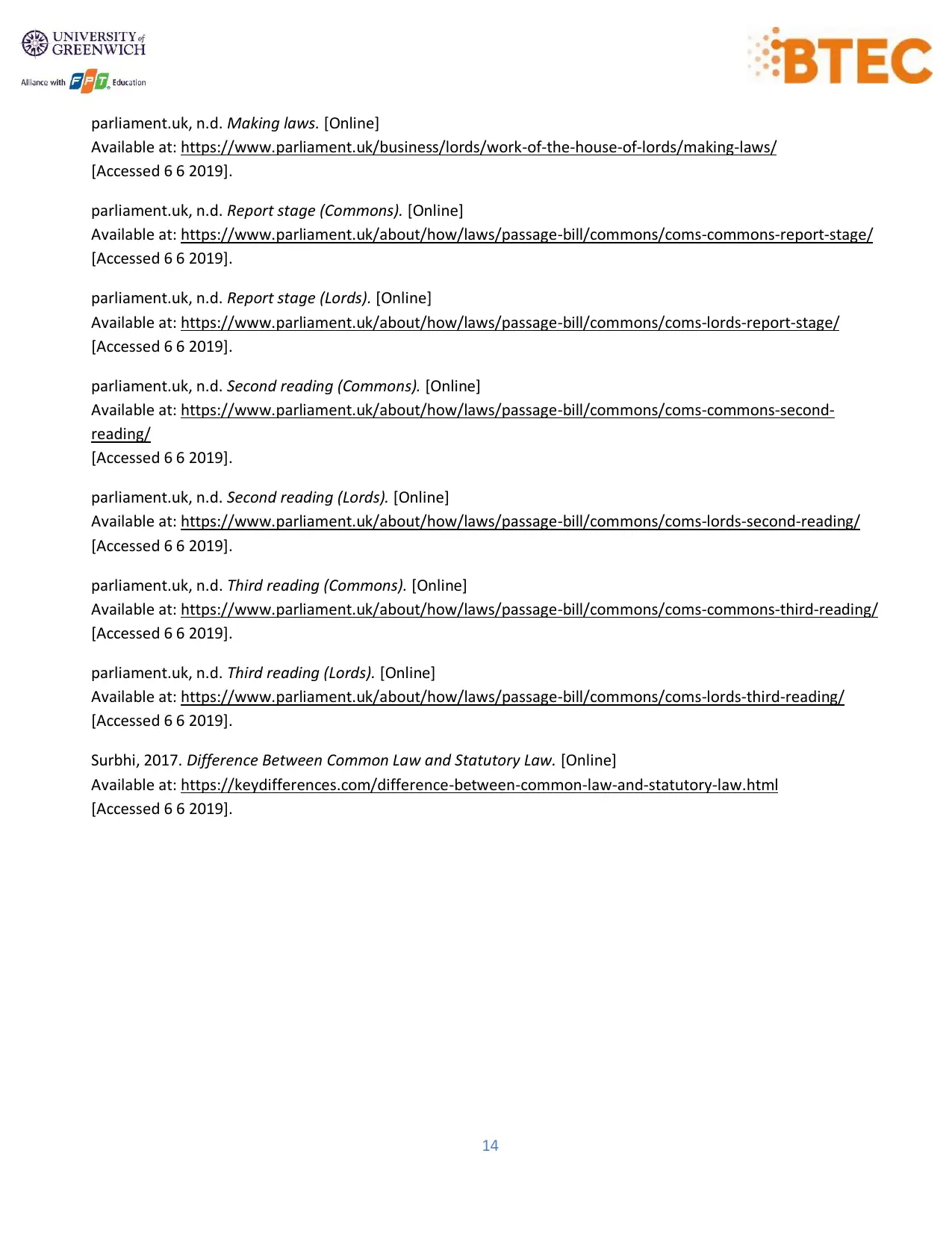
14
parliament.uk, n.d. Making laws. [Online]
Available at: https://www.parliament.uk/business/lords/work-of-the-house-of-lords/making-laws/
[Accessed 6 6 2019].
parliament.uk, n.d. Report stage (Commons). [Online]
Available at: https://www.parliament.uk/about/how/laws/passage-bill/commons/coms-commons-report-stage/
[Accessed 6 6 2019].
parliament.uk, n.d. Report stage (Lords). [Online]
Available at: https://www.parliament.uk/about/how/laws/passage-bill/commons/coms-lords-report-stage/
[Accessed 6 6 2019].
parliament.uk, n.d. Second reading (Commons). [Online]
Available at: https://www.parliament.uk/about/how/laws/passage-bill/commons/coms-commons-second-
reading/
[Accessed 6 6 2019].
parliament.uk, n.d. Second reading (Lords). [Online]
Available at: https://www.parliament.uk/about/how/laws/passage-bill/commons/coms-lords-second-reading/
[Accessed 6 6 2019].
parliament.uk, n.d. Third reading (Commons). [Online]
Available at: https://www.parliament.uk/about/how/laws/passage-bill/commons/coms-commons-third-reading/
[Accessed 6 6 2019].
parliament.uk, n.d. Third reading (Lords). [Online]
Available at: https://www.parliament.uk/about/how/laws/passage-bill/commons/coms-lords-third-reading/
[Accessed 6 6 2019].
Surbhi, 2017. Difference Between Common Law and Statutory Law. [Online]
Available at: https://keydifferences.com/difference-between-common-law-and-statutory-law.html
[Accessed 6 6 2019].
parliament.uk, n.d. Making laws. [Online]
Available at: https://www.parliament.uk/business/lords/work-of-the-house-of-lords/making-laws/
[Accessed 6 6 2019].
parliament.uk, n.d. Report stage (Commons). [Online]
Available at: https://www.parliament.uk/about/how/laws/passage-bill/commons/coms-commons-report-stage/
[Accessed 6 6 2019].
parliament.uk, n.d. Report stage (Lords). [Online]
Available at: https://www.parliament.uk/about/how/laws/passage-bill/commons/coms-lords-report-stage/
[Accessed 6 6 2019].
parliament.uk, n.d. Second reading (Commons). [Online]
Available at: https://www.parliament.uk/about/how/laws/passage-bill/commons/coms-commons-second-
reading/
[Accessed 6 6 2019].
parliament.uk, n.d. Second reading (Lords). [Online]
Available at: https://www.parliament.uk/about/how/laws/passage-bill/commons/coms-lords-second-reading/
[Accessed 6 6 2019].
parliament.uk, n.d. Third reading (Commons). [Online]
Available at: https://www.parliament.uk/about/how/laws/passage-bill/commons/coms-commons-third-reading/
[Accessed 6 6 2019].
parliament.uk, n.d. Third reading (Lords). [Online]
Available at: https://www.parliament.uk/about/how/laws/passage-bill/commons/coms-lords-third-reading/
[Accessed 6 6 2019].
Surbhi, 2017. Difference Between Common Law and Statutory Law. [Online]
Available at: https://keydifferences.com/difference-between-common-law-and-statutory-law.html
[Accessed 6 6 2019].
1 out of 15
Related Documents
Your All-in-One AI-Powered Toolkit for Academic Success.
+13062052269
info@desklib.com
Available 24*7 on WhatsApp / Email
![[object Object]](/_next/static/media/star-bottom.7253800d.svg)
Unlock your academic potential
© 2024 | Zucol Services PVT LTD | All rights reserved.





